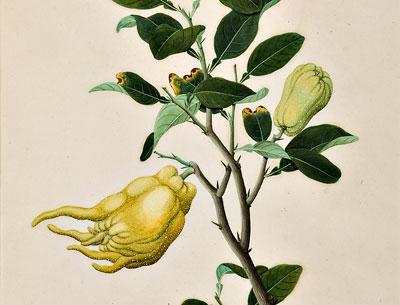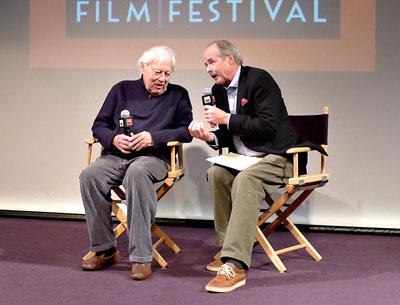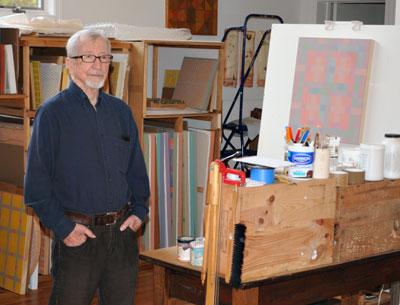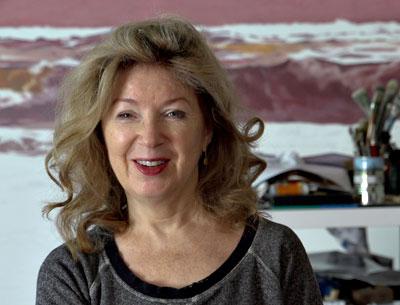The Art Scene 12.11.14
The Art Scene 12.11.14

“Winter Salon”
The Drawing Room in East Hampton will open its “Winter Salon” tomorrow morning at 10. The exhibition includes work by 37 contemporary artists as well as a selection of historical works on paper. Participating artists include Polly Apfelbaum, Carol Gove, Robert Harms, Sue Heatley, Robert Jakob, Vincent Longo, Diane Mayo, Raja Ram Sharma, and Jane Wilson.
The gallery’s winter hours are Fridays and Saturdays from 11 a.m. to 5 p.m. and Sundays from 11 to 4.
Parrish’s New Installation
The Parrish Art Museum has completed the third installation of its permanent collection galleries since moving to Water Mill in November 2012. “The Permanent Collection: Art. Illuminated” includes important recent acquisitions as well as works from the collection that have never before been exhibited.
Notable acquisitions include Philip Pearlstein’s pencil drawing “Two Nudes on a Bamboo Recliner and Linoleum” (1984), Chuck Close’s “Self-Portrait/ Photogravure” (2005), and a series of three small paintings on paper by Eric Fischl from 1984.
Other artists with new works in the collection are Michelle Stuart, Robert Kushner, Donald Lipski, Betty Parsons, Diane Tuft, Ry Rocklen, and Clegg & Guttmann.
Two sculptures by Lynda Benglis, “Untitled” (1971) and “Spiracle” (circa 1977), and the Norman Jaffe pencil drawing “Krieger House, Montauk, NY” (1977) are among the pieces from the museum’s holdings that are being shown for the first time.
Behold, “Doll Closet”
The Watermill Center will present an open rehearsal of Amber Hawk Swanson’s “Doll Closet,” a weeklong performance, on Saturday from 4 to 6 p.m. A video and performance artist from Brooklyn currently in residence at the center, Ms. Hawk Swanson has been involved with the doll community since she commissioned Amber Doll, a life-size sex doll made in her likeness, in 2006.
Made possible by Jesse, an anonymous doll owner, “Doll Closet” is inspired by a hidden room Jesse built in his home where he secretly kept his 1998 model RealDoll, Heather, for 15 years. During the course of the performance, Ms. Hawk Swanson will build a replica of Heather’s room, guided by Jesse, who will call in daily. The performance will be broadcast via Livestream each morning. The open rehearsal is free, but reservations are required.
Mannequins at Play
The Parrish Art Museum will offer another perspective on dolls on Saturday at 11 a.m. with a panel discussion titled “Dolls and Mannequins at Play in Contemporary Art.” Participants will be Eric Fischl, a North Haven artist, Glenn Fuhrman, a collector, Lisa Dennison, Sotheby’s North and South American chairman and former director of the Guggenheim Museum, and Robert Stein, a child psychoanalyst.
The use of inanimate objects such as dolls and mannequins as surrogates for personal identity and as a means to explore issues of youth and beauty, violence, sexual and gender identity, and loneliness has engaged artists throughout history. The panel discussion coincides with “Disturbing Innocence,” an exhibition organized by Mr. Fischl and currently on view at the FLAG Foundation in Chelsea.
Landscapes at Canio’s
Canio’s Books in Sag Harbor will open “Landscapes: Real and Imagined,” a show of work by Pamela Collins Focarino, Pat Moran, and Kathryn Szoka, with a reception tomorrow from 5 to 6 p.m. The exhibition will continue through Jan. 15.
Ms. Focarino, a Springs artist, will show her latest oil and Venetian plaster paintings on board. Her work focuses on light and the color and texture of clouds and water.
Mr. Moran, who lives in Sag Harbor, will show his reverse paintings on glass and a selection of monotype prints. His monochromatic palette conjures fanciful landscapes that, in his words, “get past the pretty picture to show the spiritual aspects of the natural world.”
Sag Harbor, Ms. Szoka’s hometown, figures in her photographs, as does the changing East End landscape, the subject of her “Vanishing Landscapes” series.
Michelle Stuart Talk
The Drawing Center in New York City will host a conversation between Michelle Stuart, an artist with a house in Amagansett, and Connie Butler, chief curator at the Hammer Museum in Los Angeles, on Saturday at 4 p.m.
The event coincides with “Silent Movies,” Ms. Stuart’s current exhibition at Tonkonow Artworks + Projects in Chelsea, which is on view through Dec. 20. For the work in the exhibition, made over the last two years, the artist drew from her vast archive of digital and analog photographs, activating their aesthetic potential by recontextualizing them into groups, often altering them to create personal stories.
After the discussion, Ms. Stuart, who had a retrospective exhibition at the Parrish Art Museum in 2013, will sign copies of two books, “Michelle Stuart: Drawn From Nature” and “Michelle Stuart: Sculptural Objects.”
Linda Stein in “Women Only”
New work by Linda Stein, an artist who divides her time between East Hampton and New York City, will be included in “Women Only,” an exhibition of the work of five artists opening today at the Flomenhaft Gallery in Chelsea and remaining on view through Feb. 21. An reception will take place today from 6 to 8 p.m.
Ms. Stein will be showing a selection of mixed-media tapestries depicting women who displayed different aspects of bravery during the Holocaust. The subjects include Anne Frank, Yukiko Sugihara, and Hannah Senesh.
The tapestries will begin to travel in October 2015, under the title “Holocaust Heroes: Fierce Females,” with stops now scheduled for Miami and Boca Raton, Fla.




